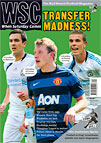 A new website tracking the accuracy of transfer rumours has started up. Adam Powley assesses the implications for football journalism
A new website tracking the accuracy of transfer rumours has started up. Adam Powley assesses the implications for football journalism
It’s the silly season, and while some fundamental questions are raised about the media, police and political establishment, it is business as usual for football. The contrivances of the transfer windows mean that almost as soon as a season ends in May, the speculation and gossip about which millionaire wants to play with which other group of millionaires begins to flow. It is easy to just blame the journalists, but there is undoubtedly a public appetite for human dramas of ambition, loyalty and greed that the business entails.
This summer a new protagonist got involved in the frenzied bunfight – the Football Transfer League website (FTL) and, in particular, its rumour statistics page for UK newspapers, footballtransferleague.co.uk. The page ranks national newspapers according to the average number of rumours each produces, provides a “user rating” and, most interestingly, a league table based on rumour accuracy, going back to 2006. The more rumours that are resolved (as a transfer or a new improved deal) the better the strike rate.
As of mid-July, the Guardian was top of the table with 190 correct rumours from a total of 566 stories. The tabloids were, not surprisingly, well down the list. From a total of 5,971 stories, the Daily Mirror reportedly got 1,155 correct, for an accuracy rate of 19.3 per cent. With a similar score, the defunct News of the World produced an average of 6.26 rumours per issue, the Independent a paltry 0.3.
At first glance, it all seems another example of the madness of modern football. In the absence of any actual worthwhile action to look at, fans can instead pore over how well newspapers are performing in the gossip trade. Yet this could serve a valuable purpose. If newspapers are judged on what they report, particularly in a reshaped industry potentially open to greater scrutiny, readers can get an idea as to which paper can be trusted to report accurately, as the people behind the site say is the intention. FTL doesn’t claim to be scientific and adds that it’s a “bit of fun”, but many fans have always been sceptical of such material and now there’s a way of measuring how trustworthy it might be.
If we are to believe the journalists themselves, it is not dissimilar to how the editorial process itself works. Sports hacks will insist that while bylines are the mainstay of the trade, reporters are also judged by their editors on how many of their stories are correct, or can “stand up” in the old Fleet Street vernacular. Hard as it may seem to believe in the current climate, but journalists will also write in good faith believing their information (often coming from agents) is genuine, even if it does not come to pass.
The wider issue revolves around the changing nature of newspaper football journalism. Thanks to the omnipotent internet and rolling news making every detail – factual or otherwise – available to consumers in an instant, newspapers do not have the immediacy, nor indeed the monopoly, that once made them essential reading. The delivery of news has altered the role of a journalist. Reporters used to report, now they have to speculate, analyse and provide opinion. With little in the way of information or exclusives to reveal, transfer “news” is a means to be heard in an increasingly shrill conversation.
It wasn’t always like this. Curmudgeonly fans might pine for the simplicity of the good old days but the football business has always thrived on tittle-tattle. A look at the Daily Mirror, for example, on a July Saturday in 1976 showed that over five-and-a-half pages of sport, just one carried football news. The lead story, taking up just a few paragraphs, reporting actual events and with attributed quotes, was the genuinely big news that Brian Clough and Peter Taylor were to reunite at Nottingham Forest. Nowadays, such a story would occupy multiple pages with, naturally, a list of outrageous transfer targets thrown in. A newspaper transfer table shedding a bit of light on such coverage might not be a bad thing.
From WSC 295 September 2011